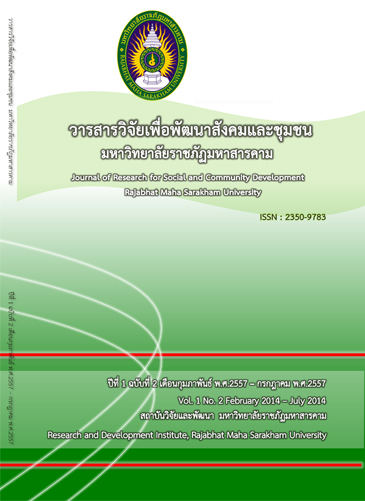การกำจัดสีย้อมในน้ำเสียสังเคราะห์ด้วยปฏิกิริยาเฟนตัน
Keywords:
synthetic waste water, dyes, fenton reactionAbstract
The Fenton method was applied to removal of color from wastewater. The purpose of this experiment was to find optimal conditions for removal of color in synthetic wastewater. The effect of different variables namely concentration of ferrous ion, concentration of hydrogen peroxide, pH of solution and reaction temperature were studied. The results showed that the optimum of hydrogen peroxide concentration and concentration of ferrous ion were 100 and 2 mM respectively, pH of solution was 4 and reaction temperature was 30 degree Celsius. It is concluded that under these optimal conditions, the removal of color was 91.23 percent.
References
Burbano et al. 2005.า Oxidation kinetics and effect of pH on the degradation of MTBE with Fenton reagentำ. Wat Res. 39, 107-118.
Faust, B.C. and J. Hoigne. 1990.า Photolysis of Fe(III)-hydroxy complexes as sources of OH radicals in clouds, fog and rainำ. Atmos. Environ. 24A, 79-89.
Giovanni Bentivenga.; Carlo Bonini.; Maurizio Dี Auria.; Adriano De Bona. 2003. Degradation of steam-exploded lignin from beech by using Fenton's reagent. Biomass and Bioenergy. 24, 233-238.
Hyunhee Lee.; Makoto Shoda. 2008.า Removal of COD and color from livestock wastwater by the Fenton methodำ. Journal of Hazapdous Materials. 153, 1314-1319.
Malik, P.K.; Saha, S.K. 2003.า Oxidation of direct dyes with hydrogen peroxide using ferrous ion as catalystำ. Sep and Puri Tech. 31, 241-250.
Maric S.; Kaptan D.; Olmez T. 2004.า Color and COD removal from wastewater containing Reactive Black 5 using Fenton oxidation processำ. J. Chemosphere. 54, 435-441.
Neamtu, M., Zaharia, C., Catrinescu, C. et al. 2004.า Fe-exchanged Y zeolite as catalyst for wet peroxide oxidation of reactive azo dye procion marine H-EXLำ. Applied Catalysis BEnvironmental. 48(4), 287-294.
Papadopoulos.A.E.; Fatta.D.; Loizidou.M. 2007.า Development and optimization of dark Fenton oxidation for the treatment of textile waste water with high organic loadำ. Journal of Hazardous Materials. 146, 558-563.
Shyh-Fang Kang.; Chih-Hsiang Liao.; Shei-Tue Po. 2000.า Decolorization of textile wastewater by photo-fenton oxidation technologyำ. Chemosphere. 41, 1287-1294.
Su reyya Meric.; Hu seyin Selc-ukb.; Vincenzo Belgiorno. 2005.า Acute toxicity removal in textile finishing wastewater by Fenton's oxidation, ozone and coagulation ะ flocculation processesำ. Wat Res. 39, 1147-1153.
Roberto Andreozzi.; Antonio Dี Apuzzo.; Raffaele Marotta. 2000.ำ A kinetic model for the degradation of benzothiazole by Fe3+-photo-assisted Fenton process in a completely mixed batch reactorำ. Journal of Hazapdous Materials. B80, 241-257.
Wongniramaikul, W., Liao, C.H. and Kanatharana, P. 2007.า Diisobutyl phthalate degradation by Fenton treatmentำ. Journal of Environmental Science and Health, Part A. 42(5), 567-572.
Downloads
Published
How to Cite
Issue
Section
License
Articles that are published are copyrighted by the authors of the articles







